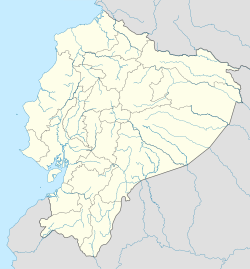Atacames | |
|---|---|
Town | |
 Atacames Beach | |
| Coordinates: 0°52′12″N79°50′56″W / 0.87002°N 79.84879°W | |
| Country | |
| Province | Esmeraldas |
| Canton | Atacames Canton |
| Area | |
• Total | 4.8 km2 (1.9 sq mi) |
| Population (2022 census) [1] | |
• Total | 18,948 |
| • Density | 3,900/km2 (10,000/sq mi) |

Atacames is a beach town and surround canton located on Ecuador's Northern Pacific coast. It is located in the province of Esmeraldas, approximately 30 kilometers south west from the capital of that province, which is also called Esmeraldas. In 2022 Atacames town had a population of 18,948, while the canton had 51,204 (in the 2022 census). Atacames has one of the lowest rates of poverty in the province of Esmeraldas (68% in 2005).
Contents
- Demographics
- Surfing in Atacames & Ecuador
- Cuisine
- Transportation in Atacames
- References
- Bibliography
- External links
During Francisco Pizarro's second conquest in 1526, he landed at Atacames. There he was unable to conquer or invade the land due to the resistance that he found in the local people who were at that time under the Incas. [2] : 111–112
In the centuries after Spanish conquest, some slave ships came from Africa. In 1553 a ship carrying slaves from Panama to Peru was stranded on Esmeralda, and the 25 slaves on board managed to escape from their captors. In the following years more escaped slaves, along with the descendants of the former slaves, developed some of the lands along the coast. Although there were also other people groups present in Atacames in the 16th century, today Afro-Ecuadoreans make up a large portion of the population in Atacames.
Tourism is Atacames's primary industry. For its population, Atacames has the highest level of hotels in the whole province of Esmeraldas. It is also easily accessible by bus from Santo Domingo, Quito, and Esmeraldas.



